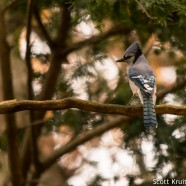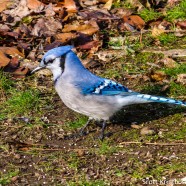Leucistic Yellow-rumped Warbler
Here is that unique Yellow-rumped Warbler which I mentioned in a previous post. Can you see what looks different about it? I noticed it naked eye while tracking various subjects in a loose flock through the trees last week including more Yellow-rumps, Black-and-white Warblers, Blue-headed Vireos, and Blue-gray Gnatcatchers. After I got my binoculars on it I realized this bird was partially leucistic, and I quickly raised my camera to snap off a record photo. Leucism in birds is when melanin pigments are produced at less than normal levels or in an unexpected pattern. In this case many of the...
Read MoreLeucistic Savannah Sparrow
This appears to be a partially leucistic Savannah Sparrow, a migrant individual that I was surprised by yesterday morning. Leucism is when pigments are produced at less than normal levels or in an unexpected pattern. In this case many of the feathers on the head and throat do not have typical pigmentation. Interestingly the yellow patch on the face can still be seen, giving this unique bird an all the more fascinating look. Scott Kruitbosch Conservation & Outreach Coordinator
Read MoreMelanistic House Sparrow (Passer domesticus)
This is one House Sparrow (Passer domesticus) I have never seen before! I took these shots last weekend, the bird being part of a group of well over 100 House Sparrows. The photos are very true to real life appearance and have not been heavily edited. Do you know why it is so dark? It appears to be melanistic which means that the dark-colored pigment melanin in the feathers was produced at higher than normal levels creating an abnormal color. The opposite is known as leucism where pigments are produced at less than normal levels or in an unexpected pattern. Melanism in small songbirds is...
Read MoreDull Blue Jay under lack of sunlight
I took this photo of a Blue Jay under very cloudy, dark and dreary conditions as a comparative example to the bird that I previously photographed and posted that was in full sunlight. See, when there is considerably less light the species appears far less blue because it is all an illusion of sorts. Missing out on the vibrant shades of some species during overcast conditions is not a deception of our eyes – the colors are just not there! Those tricky birds… Scott Kruitbosch Conservation & Outreach Coordinator
Read MoreBlue Jay (Cyanocitta cristata)
I feel as if I am still being constantly reminded of the many Blue Jays (Cyanocitta cristata) around with acorns crunching under my feet and calls of busy birds screeching out of yards, parks, and woodlands. They can look so vibrantly blue on sunny days, but that color is caused by sunlight being scattered by specialized cells in their feather barbs. Yep, the Blue Jay has no blue pigment! Scott Kruitbosch Conservation & Outreach Coordinator
Read More








